The Best of Modern Arabian Fantasy, Part II: Judith Tarr and Alamut
 No series on the best of modern Arabian fantasy would be complete without going back to the book that many credit with starting the whole trend, Alamut by Judith Tarr.
No series on the best of modern Arabian fantasy would be complete without going back to the book that many credit with starting the whole trend, Alamut by Judith Tarr.
I had the privilege of talking with Judy about the book and her process for research and writing, and her answers are insightful and fascinating. In what follows, I ask how she took her strong academic background and applied it to building the world and characters that captured the fascination of readers and writers alike.
She lists her favorite source materials and works of Middle Eastern literature that she’d recommend to readers today, and gives us a sneak peek into her exciting, upcoming projects, which also will feature the setting and culture of the Middle East.
An Interview with Judith Tarr
Conducted and edited by Emily Mah, April, 2012
Click on any of the book covers below for larger images.
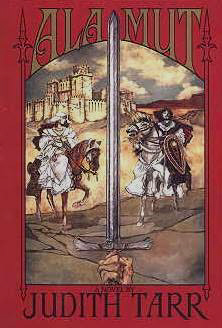 Emily Mah: Alamut has been credited by some with inspiring the current wave of Arabian fantasy. At the time you were writing it, did it seem to you that you were taking on a subgenre that hadn’t been explored much before?
Emily Mah: Alamut has been credited by some with inspiring the current wave of Arabian fantasy. At the time you were writing it, did it seem to you that you were taking on a subgenre that hadn’t been explored much before?
Judith Tarr: At the time, in the early to mid-Eighties, there was a fair amount of Arabesque fantasy. This was before the fall of the Soviet Union, when the bugbear under the bed was the Communist Menace.
When that was no longer available to feed the fears of the patriotic and the belligerent, the Muslim Menace took its place — and the tales of Arabia and the Muslim Middle East rapidly lost popularity.
Around the time I was starting Alamut, Susan Shwartz was editing her Arabesques anthologies (in which I had stories), and Esther Friesner published the humorous fantasy, Mustapha and his Wise Dog, for example.
Plus people were still reading orientalist (as we called it then) fantasies including the Arabian Nights in new editions, and various titles in the Ballantine Adult Fantasy Series.
I was working in a long tradition, but one thing I tried to do that wasn’t so common was to show the eastern characters as perfectly ordinary within their own environment, rather than as exotic or “foreign.” That’s always been a thing with me.
What inspired you to set your work in the Middle East? Can you tell us a little about the time period and what about it attracted you?
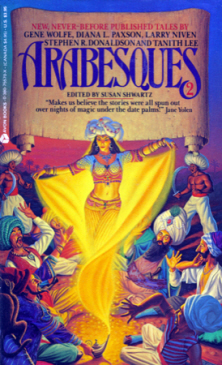 I can tell you exactly where Alamut came from: a record album, Music of the Crusades, by David Munrow and the Early Music Consort of London.
I can tell you exactly where Alamut came from: a record album, Music of the Crusades, by David Munrow and the Early Music Consort of London.
A friend at Cambridge University had put me onto it, and to medieval music in general. I loved the sound of it and became fascinated by the history behind it.
Then one day I thought about what kind of person might sing “Chevalier, mult estes guariz” (which has the most wonderful hoofbeat cadence, and is sung on the album by a bold bass-baritone). I started to write a scene. The scene became a chapter. And there we were.
Clearly you’ve got a strong academic background, learning languages and history. Can you describe your research process as you explored the setting for this series? How did you go from an intellectual understanding to the a deeper, emotional one you achieved so well?
Thank you for the compliments. I was in graduate school at the time, and had access to a world-class university library, as well as combat training in research techniques. There was no Google and barely an internet at the time; I was dealing with physical copies of books, card catalogues that were actual cards, and the mysteries and lore of the Interlibrary Loan.
One thing I had been taught as an academic historian was to start with primary sources — eyewitness accounts and works written during or soon after the events I was studying. Later histories and scholarship contributed a great deal, of course, but for the novelist, the primary sources were and are the place in which it all began.
The songs of the Crusades were my personal entry to the world; I read such documents as I could find, and I especially looked for the viewpoint of the non-European side.
I read translations of the Koran, I tracked down such collections of sources as The Crusades Through Arab Eyes, and I did my best to broaden my knowledge of the period by getting away from Western-centric sources and scholarship.
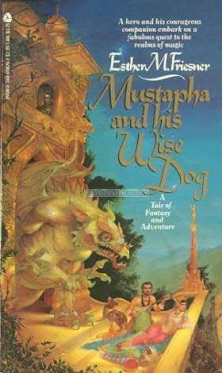 The emotional connection is something that I don’t believe can be taught, though it’s possible to guide a student toward it. There’s a great deal more to evoking a world than racking up entries in a bibliography. It doesn’t matter if you’ve spent ten years and read ten thousand books if you haven’t internalized the lives and the cultures you’re trying to write about.
The emotional connection is something that I don’t believe can be taught, though it’s possible to guide a student toward it. There’s a great deal more to evoking a world than racking up entries in a bibliography. It doesn’t matter if you’ve spent ten years and read ten thousand books if you haven’t internalized the lives and the cultures you’re trying to write about.
And the first thing anyone has to do, when trying to accomplish this, is to shut off the internal voice that says, “My culture is The Best, The Greatest, The Summit of Creation.”
It’s examining assumptions. Questioning beliefs. Asking question after question. “Is this really how people felt? Am I portraying this world as it would have been, or as my personal values and beliefs would like it to be?”
I had learned by then through long discussions with editors and readers that if a writer is too accurate, she risks losing the modern readers who have to find some way into the world she’s created. That means a character the reader can sympathize or identify with (even in a negative sense — hating his guts but relating to what he does in ways that keep the reader reading), and a viewpoint that lets the reader become a part of the action and the setting.
Go too far and you end up with a total anachronism, but that’s part of the writer’s dance: to stay somewhere in the middle.
I believe it’s important to try to “be” the character as much as possible. I’m a Method writer, I suppose. If a character is acting in accordance with his or her time and place and personality, I make a point of not judging those actions with my modern values.
I try to show that people are still people, and lives are still lives, though they may be based on very different assumptions than we consider standard or universal (because they’re ours, and the world revolves around us). They weren’t “just like us,” at all — writers who think that are just as far off as writers who spend their time judging and editorializing about people who are not-them.
What I’m trying to do is show that no matter how different people might have been, they were still human. That humanity is what I try to bring across.
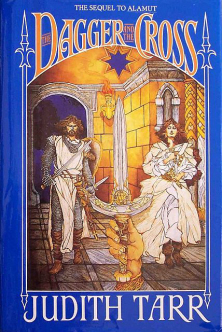 One thing that I found fascinating as I read was your ability to get into the heads of women from this era and culture. The way they relate to their husbands and the way the social rules shape their behavior will be foreign to most of your readership, yet you represent it all in a way that is comprehensible to a Western reader. Did you find this a particular challenge when you wrote ALAMUT?
One thing that I found fascinating as I read was your ability to get into the heads of women from this era and culture. The way they relate to their husbands and the way the social rules shape their behavior will be foreign to most of your readership, yet you represent it all in a way that is comprehensible to a Western reader. Did you find this a particular challenge when you wrote ALAMUT?
Not really. I’m the daughter of a Fifties housewife and the granddaughter of women who came of age around the First World War.
I also, at the time, had roommates from countries in which women were still regarded very much as second-class citizens. I listened when they talked, and I asked many, many questions.
Then I’d go to the library and read other testimonials from those cultures. Then I’d put it all together and write about human beings doing what human beings do within the bounds of their different cultures.
That blog this past week that so many are praising, about how it wasn’t all grim and nasty in the Middle Ages and fantasy writers should be more truly realistic?
The one that completely ignores all the women writers who have been doing and saying this for decades? I agree with him, though he’s rendered me and all my female colleagues completely invisible.
Our readers will of course be familiar with well known Arabian works like ARABIAN NIGHTS, and Howard Andrew Jones in a previous interview in this series recommended the Persian epic poem, The Shanameh, by Abolqasem Ferdowski. Are there any other works of great Middle Eastern literature or lore that you’d recommend to someone interested in learning more about the milieu?
The Koran. Best translation you can get your hands on, if you can’t read it in Arabic (which one is supposed to do because no translation can do it justice). All those people who are burning it would never, ever read it, because of they did, they might discover that it’s nothing like what they’re claiming.
 Muhammad was seriously ahead of his time in many ways, notably in his views toward women (regardless of what has since been done in his name — which he would approve of no more than Jesus would approve of what’s been done to his teachings by so many of his alleged followers).
Muhammad was seriously ahead of his time in many ways, notably in his views toward women (regardless of what has since been done in his name — which he would approve of no more than Jesus would approve of what’s been done to his teachings by so many of his alleged followers).
Kalila and Dimna — Persian romance, lovely and lively and full of revealing details about the culture.
The memoirs of Usamah ibn Munqidh — talk about getting inside the head of a character.
Howabout academic works for the intellectually curious. Were there any sources that you relied upon particularly to learn about the culture and era?
The above-mentioned The Crusades Through Arab Eyes, by Amin Maalouf — primary sources, some quite illuminating. Bernard Lewis’ works on the Assassins, and on Crusader history generally.
For the writer, the historical atlases one can find on sale in bookstores are priceless for details and illustrations. The Atlas of the Crusades, of course. And the Osprey Men-at-Arms series, with all its lavishly illustrated little volumes and articles about the way of war at the time.
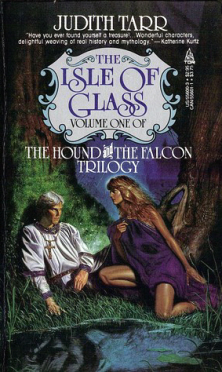 How much did your research influence the magic system you created for Alamut?
How much did your research influence the magic system you created for Alamut?
I didn’t create a magic system. It’s inherent in the characters, who are not elves. They’re mutated humans with psi powers (OK, shapeshifting, too, but I blame the X-Men and the Fantastic Four for that). (Hello, Andre Norton and Marion Zimmer Bradley and Ann McCaffrey and Katherine Kurtz and Stan Lee and …)
Clarke’s Law. At the time, what those people do was called magic. If I’d set the books a thousand years in the future instead, it would be science fiction and they’d be using psi.
I’ve read many different accounts of djinni; are there any in particular you relied upon for your djinni characters, or are their particulars more the product of your own creativity?
See above. Comic books. Science-fiction novels. Girls get steered into fantasy. I can’t help it if I keep writing science fiction anyway.
Do you read much of the current Arabian fantasy being published today? Are there any works you’ve especially liked and want to recommend?
I have to admit I don’t read as much as I used to. I run a horse farm and an editing business, and I write.
When I read, I tend to read murder mysteries. I can lose myself in those and not have to fight off my internal editor or author that wants to either rewrite it or write my own.
If I read about matters Middle Eastern or medieval, I’m reading nonfiction. I’ve followed the Arab Spring closely. This is the world the Crusaders created, and it’s playing out in fire and blood. I hope, hope, hope, that the various uprisings will succeed.
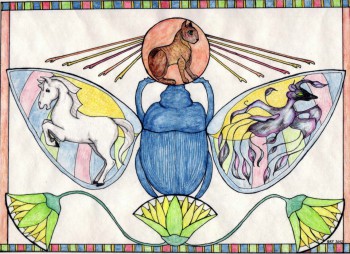
Howabout your current writing projects and recent releases? Can you tell us what you are working on now?
I just successfully funded a Kickstarter for a YA novel that no publisher would touch because it’s sf AND fantasy AND historical AND contemporary — and it’s partly set in Egypt. That will come out from Book View Cafe after it’s revised and polished, probably this fall.
I’m working on an alternate history with a brilliant up-and-coming writer (19th century US).
And I have a space opera that I’ve been told would do just great if I were a young male author, but since I’m not, I’ll finish it and probably bring it out from Book View Cafe. That one has Muslim female protagonists along with influences from India and Aboriginal Australia.
Still in the Middle East, one way or another. I keep coming back to that. Maybe I’ll just blame it on David Munrow.
Sounds exciting! A huge thank you to Judith Tarr for this wonderful interview.
You can read the other installments of The Best of Modern Arabian Fantasy series here:
Part I: Howard Andrew Jones and The Desert of Souls
Part II: Judith Tarr and Alamut
Part III: Kai Meyer and The Stormkings
Part IV: C.A. Suleiman
Part V: Saladin Ahmed and Throne of the Crescent Moon
-Emily Mah
www.emilymah.com
As it happens, Judith Tarr’s afterword in Alamut was what introduced me to Music of the Crusades and to medieval music in general.
[…] Best of Modern Arabian Fantasy here: Part I: Howard Andrew Jones and The Desert of Souls Part II: Judith Tarr and Alamut Part III: Kai Meyer and The Stormkings Part IV: C.A. […]
[…] of Modern Arabian Fantasy here: Part I: Howard Andrew Jones and The Desert of Souls Part II: Judith Tarr and Alamut Part III: Kai Meyer and The Stormkings Part IV: C.A. Suleiman Part V: Saladin Ahmed and Throne of […]
[…] can read the other installments of The Best of Modern Arabian Fantasy series here: Part II: Judith Tarr and Alamut Part III: Kai Meyer and The Stormkings Part IV: C.A. Suleiman Part V: Saladin Ahmed and Throne of […]
[…] day and age; consider Enily Mah’s series of posts on this website about Arabian fantasy, here and here and here and here and here). But it’s one thing to use trappings, it’s another to use them […]